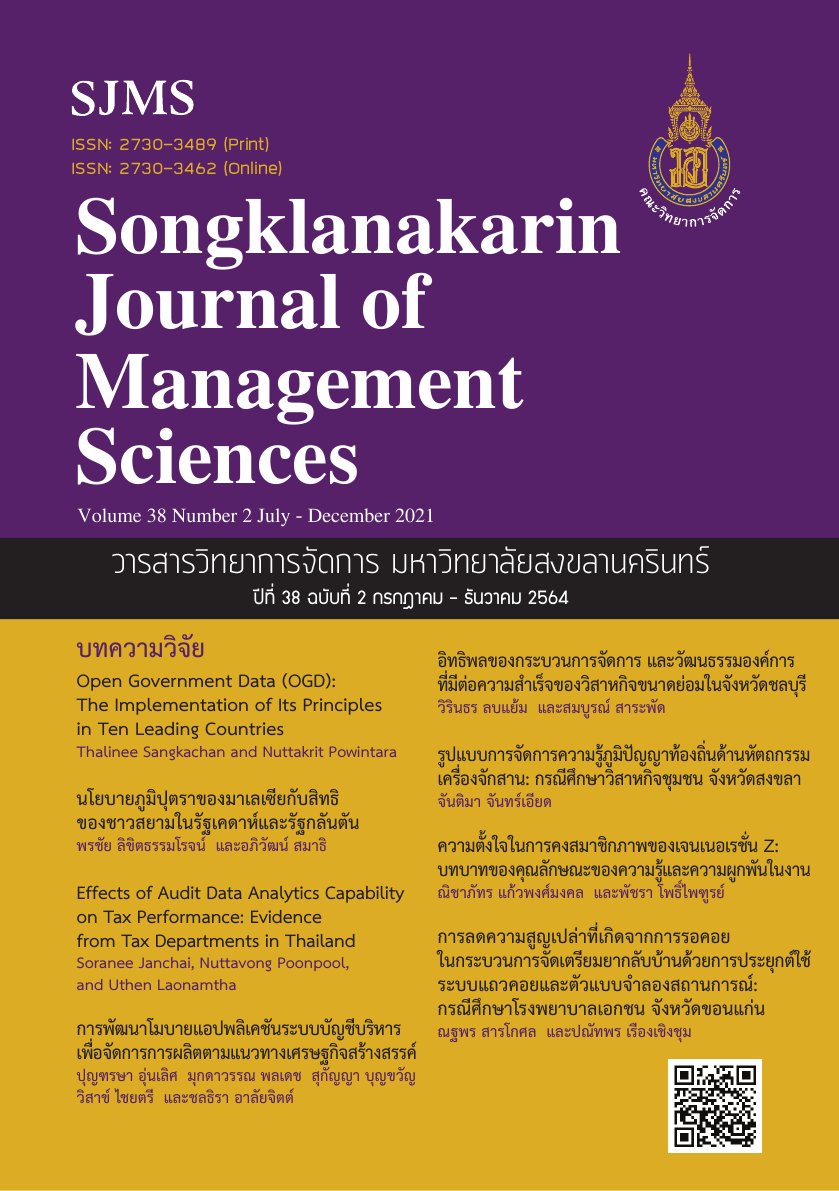Reduction of Waste of Waiting in Prescription Dispensing Process Using Queuing System and Simulation Model: A Case Study of Private Hospital in Khon Kaen Province
Main Article Content
Abstract
Reduction of waste of waiting is highly related to the increase in service receiver satisfaction. The aim of this research was to provide waste reduction for the prescription dispensing process by applying an amended queuing system and model simulation together with ECRS techniques. Data were collected via participant observations and in-depth interviews with 15 key informants and then analyzed through a process flow-chart mapping to determine value added activities, non-value added - but necessary activities, and non-value-added activities, together with ECRS techniques, queuing system analysis and simulation model. The results showed that the major contributors to non- value added time were associated with prescription waiting for verification and medication waiting for checking period. Model simulation demonstrated that by amending the queuing system, waiting time was reduced from 39.64 minutes to 13.88 minutes. Consequently, this contributed to more than a 75% improvement in service receiver satisfaction. Therefore, reduction of waste of waiting for prescription dispensing process should be emphasized among all staff as it is a predictor of service receiver satisfaction in order to improve efficiency and hospital service standards.
Article Details

This work is licensed under a Creative Commons Attribution-NonCommercial-NoDerivatives 4.0 International License.
All published articles are SJMS’s copyright. The editorial board allows all published articles to be copied, excerpted, or disseminated with academic citation.
References
Affleck, A., Parks, P., Drummond, A., Rowe, B. H., & Ovens, H. J. (2013). Emergency department overcrowding and access block. Canadian Journal of Emergency Medicine, 15(6), 359-370.
Bahadori, M., Mohammadnejhad, S. M., Ravangard, R., & Teymourzadeh, E. (2014). Using queuing theory and simulation model to optimize hospital pharmacy performance. Iranian red crescent medical Journal, 16(3). Retrieved April 20, 2020, from https://sites.kowsarpub.com/ircmj/issue/1777.html
Boyd, S. (2017). Hospital administrators' strategies for reducing delayed hospital discharges and improving profitability. (Doctoral dissertion). Walden University, Minneapolis, MN.
Caetano, A., Silva, A. R., & Tribolet, J. (2010). Business Process Decomposition-An Approach Based on the Principle of Separation of Concerns. Enterprise Modelling and Information Systems Architectures, 5(1), 44-57.
Dan, Z., Xiaoli, H., Weiru, D., Li, W., & Yue, H. (2016). Outpatient pharmacy optimization using system simulation. Procedia Computer Science, 91(2016), 27-36.
Fatima, T., Malik, S. A., & Shabbir, A. (2018). Hospital healthcare service quality, patient satisfaction and loyalty. International Journal of Quality & Reliability Management, 35(6), 1195-1214.
Goldman, J., MacMillan, K., Kitto, S., Wu, R., Silver, I., & Reeves, S. (2018). Bedside nurses’ roles in discharge collaboration in general internal medicine: Disconnected, disempowered and devalued? Nursing inquiry, 25(3). Retrieved April 20, 2020, from https://onlinelibrary.wiley.com/doi/full/10.1111/nin.12236
Gopalakrishnan, T., & Saravanan, R. (2017). Cast Off expansion plan by rapid improvement through Optimization tool design, Tool Parameters and using Six Sigma’s ECRS Technique. IOP Conference Series: Materials Science and Engineering, 183(1), 12-16.
Heizer, J., Render, B., & Munson, C. (2017). Principles of Operations Management: Sustainability and Supply and Supply Chain Management. (10th ed). New York: Pearson Education.
Hillier, F. S. (2012). Introduction to Operations Research. Tata McGraw-Hill Education.
Krungsri Research Center. (2019). Thailand industry outlook 2019-21: Private Hospital Industry. Retrieved July 21, 2020, from https://www.krungsri.com/bank/getmedia/587ccdaa-91a8-a86f-30ea43558f0b/IO_Private_Hospital_19624_EN_EX.aspx
Mohammadi, M., & Shamohammadi, M. (2012). Queuing analytic theory using WITNESS simulation in hospital pharmacy. International Journal of Engineering and Technology, 12(6), 20-27.
Niloy, S., & Tatini, N. (2016). Analysis of patient waiting time for hospital admission and discharge process. International journal of advanced research, 4(8), 1097-1108.
Office of the Permanent Secretary for Ministry of Agriculture and Cooperatives. (2011). Key Performance Indicators. Retrieved July 25, 2020, from https://www.opsmoac.go.th/km-km_org_center-files-391691791813
Ohno, T. (2016). The Toyota Production System-The Key Elements and the Role of Kaizen within the System. Germany: Campus Verlag.
Omar, M. M. A., & Abdullah, K. A. (2016). The Use of the Probability Tree Diagram to Test the Integrated Model in Building the Management Information Systems. Global Journal of Management and Business Research, 16(1), 18-28.
Peltan, I. D., Bledsoe, J. R., Oniki, T. A., Sorensen, J., Jephson, A. R., Allen, T. L., ... & Brown, S. M. (2019). Emergency department crowding is associated with delayed antibiotics for sepsis. Annals of emergency medicine, 73(4), 345-355.
Phanprasat, D., & Ruangchoengchum., P. (2019). Labor Productivity Improvement by Reducing Waste in Carwash Process: A Case Study of Carwash Business in Kalasin Province. Journal of Management science, 36(2), 113-139.
Pharmacy Department. (2020). Key Performance Indicator Annual Report. Khon Kaen: Bangkok Hospital Khon Kaen.
Pisatpeng, R. (2010). Arena Manual for Simulation Model (Revised edition). Bangkok: SE-EDUCATION.
Rasouli, H. R., Esfahani, A. A., Nobakht, M., Eskandari, M., Mahmoodi, S., Goodarzi, H., & Farajzadeh, M. A. (2019). Outcomes of crowding in emergency departments; a systematic review. Archives of academic emergency medicine, 7(1). Retrieved April 20, 2020, from http://journals.sbmu.ac.ir/aaem/index. php/AAEM
Total Quality and Cost Improvement Division. (2020). Hospital Service Annual Report. Khon Kaen: Bangkok Hospital Khon Kaen.
Shahnawaz, H., Farooq A. J., & Haroon, R. (2016). Study of hospital discharge process viz a viz prescribed NABH standards. International journal of contemporary medical research, 5(8), H1-H4.

